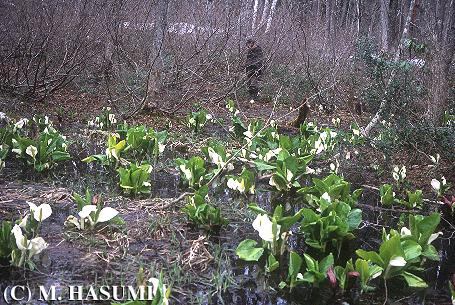
(1) 28 April (1635-1800 h; data in chronological order because of the appearance of various phases of reproduction): H. hidamontanus: 1 gravid female in a preovulatory condition in the water, 1 pair of egg sacs including embryos of the 16-cell stage among decaying leaves in the water, 1 pair of egg sacs including embryos of the morula stage at a twig in the water, 1 spent female in the water, 1 gravid female after completing egg sac formation in the water, 1 spent female under a log above ground on land at a distance of approximately 60 cm from the edge of the water, and 1 juvenile seemed to metamorphose last fall among decaying leaves on land at a distance of about 1.2 m from the edge of the water; and the frog Rana ornativentris: 1 male in the water (water pH = 6.0).
(2) 29 April (1500-1545 h; additional data in chronological order): H. hidamontanus: 1 gravid female after completing egg sac formation in the water, 6 pairs of egg sacs including embryos between the 8-cell stage and the 32-cell stage in the water, 1 spent female in the water, 1 male in the water, and 1 gravid female during ovulation on land at a distance of 50 cm from the edge of the water (evidence for wandering, as well as the case of Hynobius kimurae; water temperature = 13.0 C, water pH = 5.9).
(3) 29 April (2145-2230 h; additional data in chronological order): H. hidamontanus, each in the water: 1 male with a typical aquatic-phase morph (characterized by increased head width, swollen body and cloacal region, and developed tailfin), 1 male, 1 pair of egg sacs just after deposition, 1 male, 1 gravid female during ovulation, 1 pair of egg sacs including embryos of the morula stage, the adhesive tips of which were attached to a tiny twig of 10 cm, 1 male, 1 gravid female during ovulation, 1 gravid female just before oviposition, 1 pair of egg sacs just after deposition, 1 male with a typical aquatic-phase morph, 1 gravid female soon before oviposition, and 1 male (water temperature = 7.6 C).
(4) 30 April (2300-2340 h; additional data in chronological order): H. hidamontanus, each in the water: 3 pairs of egg sacs just after deposition, 1 gravid female in a preovulatory condition presumably just after entering the water, 1 pair of egg sacs just after deposition, 3 pairs of egg sacs seemingly deposited last night, 2 males having the distinctive aquatic-phase morph, and 1 small overwintering larva (total length = 35 mm); and R. ornativentris: 1 juvenile in the water.
(5) 14 May (2315-2340 h; additional data): H. hidamontanus, each in the water: 25-30 pairs of egg sacs including embryos between the late neural-fold stage and the elongated tail-bud stage, most being the tail-bud stage, and 1 small male; and R. ornativentris: 1 juvenile in the water.
We estimated the breeding season of this population of H. hidamontanus began around 28 April 2005, and 14 May was near the cessation of the breeding season. Thus, the onset of the breeding season this year was more delayed than usual by a couple of weeks with much remaining snow.
Accompanied Research Collaborators (in alphabetical order every organization): Kaname Arai and Shinkichi Ueki (Nature Conservation Unit, Environment and Nature Conservation Division, Living Environment Department, Nagano Prefectural Government), Masaichi Kakegawa (Tokyo Metropolitan Komatsugawa Senior High School), Fujio Kishi and Yuko Saikawa (Shirouma Association of Naturalists), and Yoichi Shibusawa and Yusuke Takeda (Citizens' Living Unit, Living Environment Division, Nagano Prefecture Kita-azumi Regional Office).